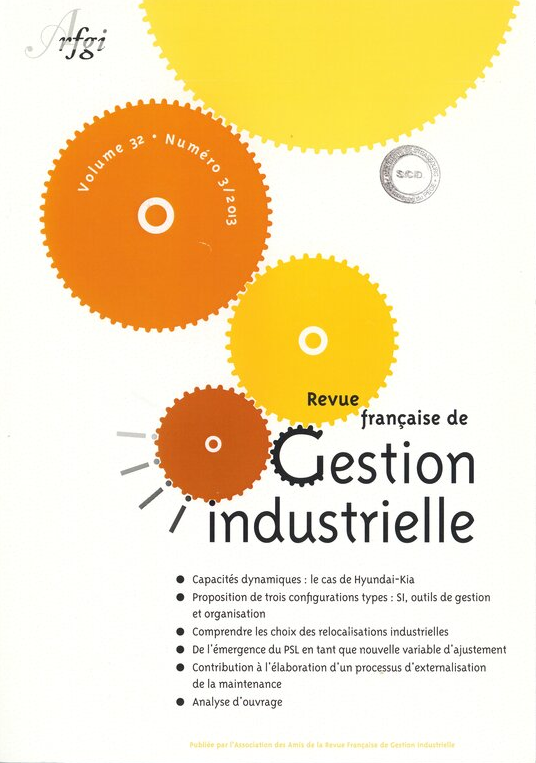Comprendre les choix de relocalisations industrielles : quel cadre théorique mettre en oeuvre ?
DOI :
https://doi.org/10.53102/2013.32.03.702Mots-clés :
Relocalisations, Global Value Chains, Transactions, RessourcesRésumé
Les relocalisations sont aujourd'hui profondement ancrees dans le debat public europeen et notamment francais, au sens ou elles participent au questionnement sur la re-industrialisation du pays. Notre article permet d'une part de clarifier les differents sens dorm& au terme de relocalisation et d'autre part de proposer un cadre theorique pour mieux comprendre les determinants des relocalisations. Le croisement des differentes theories proposees - l'approche par le territoire et en particulier la theorie centre-peripherie, la GVC, la theorie des coats de transaction et la theorie des ressources - enrichit la comprehension du phenomene. Les deux cas d'entreprises ici present& offrent la possibilite, dans leur diversite, d'apprehender l'interet de ces theories. Au-dela, ils mettent en exergue les dangers d'une &localisation mal maitrisee et les enjeux strategiques d'une relocalisation reussie.
Références
Amit R. et Schoemaker P. (1993), «Strategic assets and organizational rent», Strategic Management Journal, vol.14 n°1, pp.33-46.
Belbenoit-Avich, J., (2009), « De la notion de relocalisation », 5eme colloque de l'Institut Franco-Bresilien d'Administration des Entreprises, IFBAE, 18 et 19 mai 2009.
Belbenoit-Avich, J., (2010), 0 Relocalisation - refle)don sur la revue de litterature », Journees d'etudes sur le management international, 12-13 mars 2010.
Coeurderoy R. et Quelin B. (1998), «La theorie des coflts de transaction : fondements theoriques et implications manageriales », Repenser la strategie : fondements et perspectives, dirige par Laroche H. et Nioche J.P., Vuibert, Paris, pp.26-60.
David, R.J., Han, S.K., (2004), «A systematic assessment of the empirical support for transaction cost economics», Strategic Management Journal, vol.25 n°1, p.39-58.
Dierickx I. et Cool K. (1989), «Asset stock accumulation and sustainability of competitive advantage», Management Science, vol.35 n°12, pp.1504-1511.
Durand, R., Gomez, P.Y., (2001), « Transactions, ressources et croissance de la firme », dans P.Joffre (dirige par), La theorie des coilts de transaction, Vuibert, p.111-127.
El Mouhoud, M., (2007), Mondialisation et &localisation des entreprises, Paris, Editions La Decouverte, p.41-48.
Fernandes, V., Akono, D., (2011), « Impact du developpement durable sur les choix de relocalisation : une approche exploratoire », Revue Frangaise de Gestion Industrielle, vol.30 n°4, p.9-23.
Gallego, V., Mahe de Boislandelle H., (2011), Delocalisation et relocalisation en PME, Economica, chapitres 3 et 4.
Gereffi, G., Humphrey, J.,Sturgeon, T., (2005), « The Governance of Global Value Chains », Review of International Political Economy, vol.12, n°1, p.78-104.
Goel, A.K., Moussavi, N., Srivastan, V.N., (2008), « Time to rethink offshoring? », Mc Kinsey on Business Technology, winter, n°14, p.32-35.
Grant, R.M., (1991), «The resource-based theory of competitive advantage: implications for strategy formulation», California Management Review, p.114-135.
Grasland, C. , Van Hamme, G., (2010), « La relocalisation des activites industrielles: une approche centre/peripherie des dynamiques mondiale et europeenne. », L'espace geographique, vol.39, n°1, p.1¬193.
Keane, J., (2008), « A 'new' approach to global value chain analysis », Working paper 293, Overseas Development Institute.
Mahoney J.T. et Pandian J.R.(1992), «The resource-based view within the conversation of strategic management» , Strategic Management Journal, vol13, pp.363-380.
Manuj, I., Mentzer, J.T., (2008), « Global supply chain risk management strategies », International Journal of Physical Distribution and Logistics Management, vol.38, n°3, p.192-223.
Mercier Suissa C., « Delocalisation-relocalisation : quel ancrage territorial pour les entreprises ? », in Mercier Suissa C. (2011), Entre delocalisations et relocalisations : mobilite des entreprises et attractivite des territoires, HEM-Kartala-IAE de Lyon, pp.17-37.
Penrose E. (1995), The theory of the growth of the firm, Oxford University Press, troisieme edition.
Peteraf, M.A., (1993), «The cornerstones of competitive advantage: a resource-based view», Strategic Management Journal, vol.14, n°2, p.179-191.
Rumelt, R.P., Schendel, D. , Teece, D.J., (1991), « Strategic Management and Economics », Strategic Management Journal, vol.12, p.5-29.
Samuelson, P.A., (2004), «Where Ricardo and Mill rebut and confirm arguments of mainstream economists supporting globalization», Journal of Economic Perspectives, vol.18, n° 3, p.135-146.
Sirkin, H.L., Zinser, M., Hohner, D., (2011), « Made in America, again. Why manufacturing will return to the US », The Boston Consulting Group, August, p.1-15.
Sturgeon, T., Van Biesebroeck, J., Gereffi, G., (2008), « Value Chains, Networks and Clusters: Reframing the Global Automotive Industry », Journal of Economic Geography, vol. 8, n°3, p. 297-321.
Williamson O.E. (1996a), «Economic organisation: the case for candor», The academy of management review, vol.21 n°1, pp.48-55.
Williamson, O.E., (1996b), The mechanisms of governance, New York, Oxford University Press
Numéro
Comment citer
Rubrique
Licence
(c) Tous droits réservés RFGI 2021

Ce travail est disponible sous licence Creative Commons Attribution - Pas d’Utilisation Commerciale 4.0 International.











